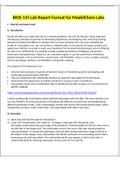Exam (elaborations)
BIOS 135 Lab Report Format for ModelChem Labs
- Course
- Institution
BIOS 135 Lab Report Format for ModelChem Labs I. Title Fly Lab Week 6 iLab II. Introduction FlyLab will allow you to play the role of a research geneticist. You will use FlyLab to study important introductory principles of genetics by developing hypotheses and designing and conducting ma...
[Show more]



